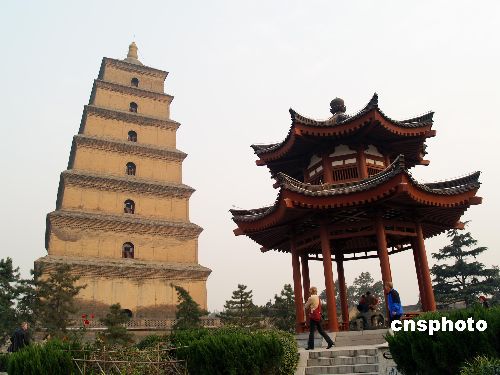Xi'an Greater Wild Goose Pagoda ceases slanting
时间:2007-01-19 02:24:39
(单词翻译:单击)

| Xi'an Greater Wild Goose Pagoda1 |
| Chinanews, Xi’an, Jan. 18 – In Xi’an, ground subsidence has become one of the major geological disasters for the city. The well-known Greater Wild Goose Pagoda, which was built in the Tang Dynasty and has existed for over 1,000 years, has slanted3 by upwards4 of 1,000 millimeters through the years. As a result of human efforts, the slanting5 trend of the pagoda has been curbed6 and the pagoda is gradually returning to its original position.
The pagoda, built in 652 A.D., is located in Ci'en Temple. The first accurate measuring about the slanting of the pagoda was made in 1719, or the 58th year of Qing-Dynasty Emperor Kangxi's reign7. By 1941, the pagoda had slanted for 413 millimeters in the northwestern direction, and the slanting was mostly caused by the great decline of the underground water level resulting from long-time overexploitation of underground water. The overexploitation had lessened8 the underground water pressure, made water squeezed out from the clay layer and caused the earth surface to subside2. The slanting speed of the pagoda has quickened since 1945. From 1985 to 1996, it slanted northwestwards at an average speed of one millimeter every year. A survey done in 1996 showed that the pagoda had slanted 1,010.5 millimeters. Since ground surface continues to subside these years, some large earth cracks have begun to show in the city, causing great damage to the city’s infrastructure9 building and city construction. In order to solve the problem, Xi’an municipal government has taken measures to prevent the pagoda from slanting further by building some 400 wells surrounding the pagoda. The measures have proved to be effective. From 1997, the Greater Wild Goose Pagoda has stopped slanting northwestwards and gradually returned to its original position. According to a recent report presented by the No.1 Team of the State Bureau of Surveying and Mapping (SBSM), by 2006, the pagoda had moved 9.4 millimeters in an opposite direction. Based on this measurement, SBSM concludes that the pagoda has now “remained in a relatively10 stable position” and will “continue to move backward in future.”
|
点击 收听单词发音
收听单词发音
 收听单词发音
收听单词发音
1
pagoda

|
|
| n.宝塔(尤指印度和远东的多层宝塔),(印度教或佛教的)塔式庙宇 | |
参考例句: |
|
|
|
2
subside

|
|
| vi.平静,平息;下沉,塌陷,沉降 | |
参考例句: |
|
|
|
3
slanted

|
|
| 有偏见的; 倾斜的 | |
参考例句: |
|
|
|
4
upwards

|
|
| adv.向上,在更高处...以上 | |
参考例句: |
|
|
|
5
slanting

|
|
| 倾斜的,歪斜的 | |
参考例句: |
|
|
|
6
curbed

|
|
| v.限制,克制,抑制( curb的过去式和过去分词 ) | |
参考例句: |
|
|
|
7
reign

|
|
| n.统治时期,统治,支配,盛行;v.占优势 | |
参考例句: |
|
|
|
8
lessened

|
|
| 减少的,减弱的 | |
参考例句: |
|
|
|
9
infrastructure

|
|
| n.下部构造,下部组织,基础结构,基础设施 | |
参考例句: |
|
|
|
10
relatively

|
|
| adv.比较...地,相对地 | |
参考例句: |
|
|
|
- 上一篇:Fengyun meteorological satellites reach world advanced level
- 下一篇:Mini satellite to be sent to monitor astronaut's activities
©2005-2010英文阅读网




